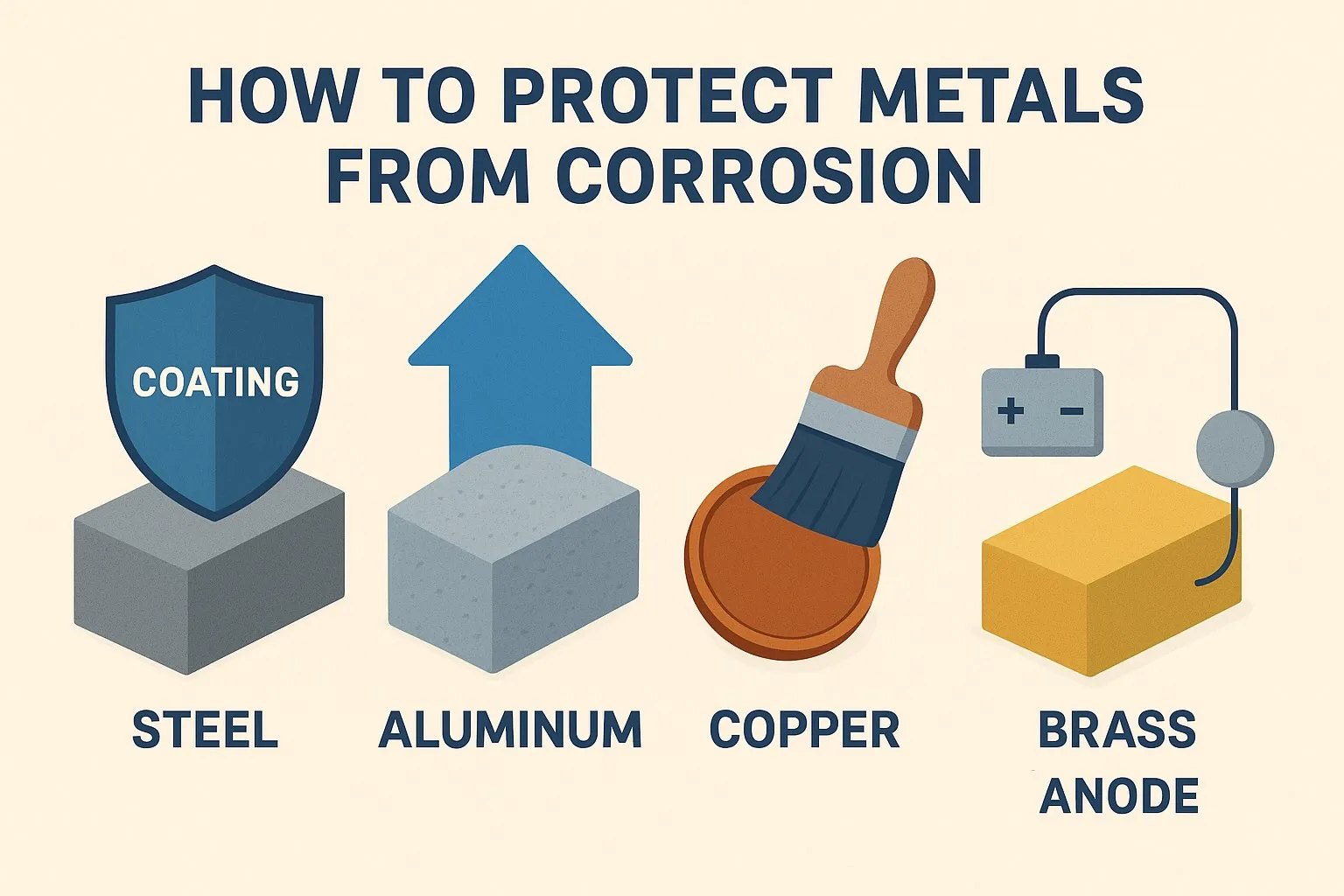Corrosion is the slow destruction of metals as they react with their environment, often reverting to oxides, hydroxides, or sulfides. It costs industries billions every year, from rusting pipelines to aircraft fatigue. Yet, with the right knowledge, we can slow it down or even prevent it entirely.
Let’s look at how different metals corrode—and what industry does to fight back.
Steel & Iron
The Problem
Plain carbon steel is one of the most widely used materials in the world, but it’s also one of the most vulnerable. In humid or salty environments, it quickly rusts into flaky, weak iron oxide.
Protection Methods & Industry Examples
- Paints and Powder Coatings – Cars are a classic example: every automobile has multiple layers of paint, not just for looks but to seal steel from oxygen and water. Bridges like the Golden Gate are constantly repainted for the same reason.
- Galvanizing (Zinc Coating) – Street light poles, guard rails, and corrugated roofing sheets are commonly galvanized. The zinc corrodes sacrificially, protecting the steel underneath.
- Stainless Steel – Adding at least 10.5% chromium creates a self-healing protective oxide. Surgical instruments, food-processing equipment, and skyscraper facades (like New York’s One World Trade Center spire) use stainless steel for durability.
- Cathodic Protection – Underground pipelines and oil rigs use sacrificial magnesium or zinc anodes to protect vast networks of steel from rust.
Aluminum
The Problem
Aluminum naturally forms a thin oxide layer that protects it, but in salty environments such as near oceans, pitting corrosion becomes a serious issue.
Protection Methods & Industry Examples
- Anodizing – Aerospace and consumer products like MacBook housings are anodized, making the surface harder and more corrosion-resistant.
- Paint/Coatings – Aircraft skins are often coated with primers and paints to shield aluminum from salt exposure at high altitudes.
- Alloy Selection – The Boeing 737 extensively uses 2024 and 7075 alloys for strength, but these need protective coatings. Meanwhile, 6061 is common in marine fittings thanks to its better corrosion resistance.
Copper
The Problem
Copper forms a green patina (basic copper carbonate) in moist air. While this layer is protective, it can tarnish surfaces or interfere with electrical conductivity.
Protection Methods & Industry Examples
- Clear Coatings – Decorative copper roofing (like the Statue of Liberty, which has its iconic green patina) sometimes uses coatings today to preserve the shiny look.
- Tin Plating – In electronics, copper wires and connectors are often tin-plated to prevent oxidation while maintaining conductivity.
- Design Consideration – Plumbing systems use copper tubing, but stagnation or acidic water can accelerate corrosion. Water treatment and flow design help minimize this.
Brass & Bronze
The Problem
Brass (copper-zinc) can suffer from dezincification in marine environments, where zinc leaches out, leaving a weak, porous copper structure. Bronze (copper-tin) generally performs better but still corrodes under some conditions.
Protection Methods & Industry Examples
- Alloy Choice – Naval brass and silicon bronze are used in ship propellers, seawater valves, and marine fasteners because of their superior resistance.
- Coatings – Musical instruments often have clear lacquers to prevent tarnishing.
- Cathodic Protection – Brass fittings in offshore oil platforms often work alongside sacrificial anodes for added durability.
Titanium
The Problem
Titanium is the corrosion champion. Its passive oxide film is incredibly stable, making it nearly immune to seawater and industrial chemicals. The only exception: fluoride-rich environments (like some industrial cleaning solutions).
Protection Methods & Industry Examples
- Aerospace – Jet engine components and airframes use titanium extensively because it resists both heat and corrosion.
- Medical Devices – Titanium implants survive decades in the human body thanks to their excellent corrosion resistance and biocompatibility.
- Marine Industry – High-performance yachts and submarines use titanium fasteners and propellers—expensive, but they essentially never corrode.
General Strategies Across All Metals
- Design Against Corrosion – Avoid crevices, allow drainage, and separate dissimilar metals to prevent galvanic corrosion. For example, in aircraft, aluminum panels are isolated from steel fasteners with insulating washers.
- Environmental Control – Refineries use corrosion inhibitors in cooling water, while museums control humidity to preserve metal artifacts.
- Maintenance & Inspection – Bridges, ships, and aircraft are regularly inspected and recoated. Offshore oil rigs even have entire teams dedicated to corrosion prevention.
Conclusion
Every metal tells a different story when it comes to corrosion. Steel needs constant protection, aluminum thrives with anodizing, copper tarnishes but stabilizes, brass needs careful alloying, and titanium simply shrugs off most environments.
For manufacturers and engineers, knowing the right strategy is the difference between a product that fails in five years and one that lasts fifty.
